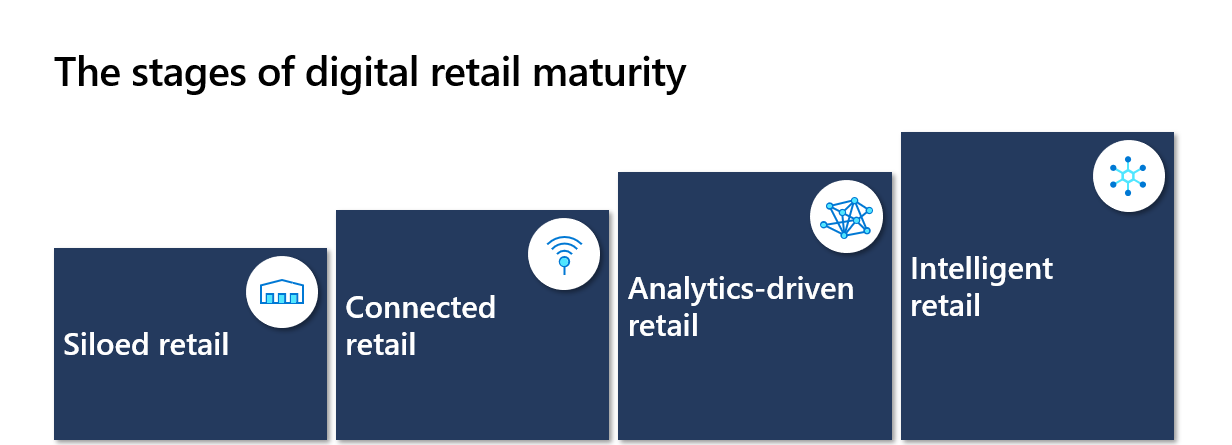Cloud maturity model for retail
The cloud is essential to remain resilient and competitive in modern retail. Cloud adoption provides a competitive advantage. It also enables cost savings, increased business agility, heightened data security, and the ability to integrate the latest technology throughout the retail value chain.
The maturity model in this article represents aspirational retail goals, and the right mix of cloud technologies has the potential to unlock these goals. But cloud adoption is a process, and each journey is unique.
Navigating the journey requires that retailers understand their current level of cloud maturity.
Siloed retail
Siloed retail organizations have little or no cloud-native adoption and data that is underutilized and not shared across departments. Some technology is in place and employees have some digital skills. But the approach taken to infrastructure, data, and applications is often oriented around single locations, departments, or use cases. This approach creates organizational inefficiencies and inhibits innovation. This stage often represents legacy patterns and practices that must be modernized during maturity to cloud adoption.
Connected retail
Connected retail organizations are further along on their cloud journey. They've established a course for infrastructure, data, and applications. These organizations often start by lifting and shifting elements of their computing infrastructure. This shift involves moving servers, storage, networking firewalls, and security to the cloud using infrastructure as a service (IaaS) offerings. It reduces operational complexities, breaks down data silos, and harmonizes data estates. Retailers in this stage often use shared services such as item catalog availability and taxation handling. They might enable innovative proofs of concept with other cloud services like AI and Internet of Things (IoT) to explore new capabilities.
Analytics-driven retail
Analytics-driven retailers focus on establishing a base for future transformation using big data, IoT, and industry-specific AI capabilities. The cloud groundwork that has been laid makes these retailers more data-driven and agile than retailers in earlier stages. During this stage, near-term innovation and actualization of the industry priority scenarios and use cases that lead the retail industry become available. These use cases, like personalization and supply chain optimization, become available across the plan, buy, sell, and move retail domains. Many retailers in this stage establish a new way to think about the data that drives their business. Microsoft recommends adopting a common data model that lets first-party and third-party solutions interact with the retail value chain that is represented by their data.
Intelligent retail
Intelligent retail organizations are at the highest end of the cloud maturity spectrum. Their domains are fully digitized and they might have started taking advantage of advanced data and AI capabilities. They might also use platform as a service (PaaS) offerings to support mission-critical workloads, like point of sale services and logistics operations. PaaS builds on the IaaS offerings already described to provide a complete cloud-based web services development and deployment environment. This environment includes middleware, development tools, business intelligence (BI) services, database management systems, and more. These retailers reinvent their organizations, maximize their differentiated assets, and fully transform their workforces.
The cloud migration journey might look difficult, but it doesn't have to happen all at once. With the right partner and a sound strategy, cloud adoption prepares retail organizations for the next generation of technology.
Next steps
Learn more about the market context used to create this maturity model and inform our retail industry-specific guidance.
The following articles can guide your cloud adoption journey and help you succeed in the cloud adoption scenario.
